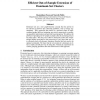Free Online Productivity Tools
i2Speak
i2Symbol
i2OCR
iTex2Img
iWeb2Print
iWeb2Shot
i2Type
iPdf2Split
iPdf2Merge
i2Bopomofo
i2Arabic
i2Style
i2Image
i2PDF
iLatex2Rtf
Sci2ools
NIPS
2004
2004
Efficient Out-of-Sample Extension of Dominant-Set Clusters
Dominant sets are a new graph-theoretic concept that has proven to be relevant in pairwise data clustering problems, such as image segmentation. They generalize the notion of a maximal clique to edgeweighted graphs and have intriguing, non-trivial connections to continuous quadratic optimization and spectral-based grouping. We address the problem of grouping out-of-sample examples after the clustering process has taken place. This may serve either to drastically reduce the computational burden associated to the processing of very large data sets, or to efficiently deal with dynamic situations whereby data sets need to be updated continually. We show that the very notion of a dominant set offers a simple and efficient way of doing this. Numerical experiments on various grouping problems show the effectiveness of the approach.
| Added | 31 Oct 2010 |
| Updated | 31 Oct 2010 |
| Type | Conference |
| Year | 2004 |
| Where | NIPS |
| Authors | Massimiliano Pavan, Marcello Pelillo |
Comments (0)

